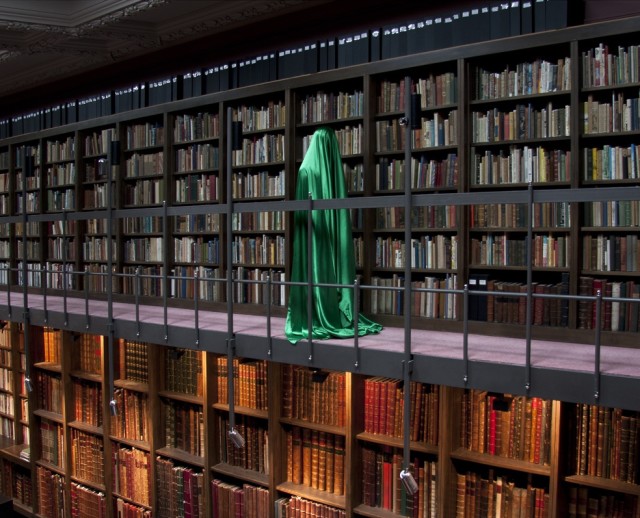London-based Turkish artist Güler Ates presents Books of Dust, a new series of photographs created in the Royal Academy of Arts ("RA") Research Library, the oldest institutional fine arts library in the United Kingdom, serving the needs of Royal Academicians, students and scholars for over 200 years.
Güler's new series of hypnotic photographs explores female identity through the lens of the artist's own experiences of cross-cultural displacement as well as accepted models of culture in the West. In these new works, a 21st century woman fully covered in swathes of brightly coloured lace or silk reminiscent of a "veil" with all its contemporary Western readings is positioned against the backdrop of the esteemed RA Library's stacks of books, some of which date back to the Academy's foundation in 1768. This juxtaposition of the old and the new as well as Middle Eastern exoticism and Victorian propriety are common themes in Güler's practice. The artist explains, "I am not directly influenced by the RA's architecture as the building is neoclassical. However, I am more interested in its relation to the Victorian era, where I feel there is a strong link to the East… there was an obsession with the East during the Victorian era. Frederic Lord Leighton would serve as a compelling example of Victorians' interest the East." According to the artist, inserting the veiled woman, a figure that is central to Ates' practice, into this architectural environment creates an image of the "other" or the "unknown", helping us to understand our own culture and its inherent meaning.
Güler's first experience of the RA Library also influenced this body of work. Ates states, "I visited the RA Library for the first time to research Lord Leighton's drawings and sketches in 2009 for my residency at the Leighton House Museum in 2010." In some of the sketchbooks of Lord Leighton, who was the president of the RA from 1879-1896, Ates recalls, "I saw images of veiled women, which he drew during his Algeria trip. They struck me as exoticising images and stayed with me for a long time." Imbuing her female subjects with a mystic exoticism that brings to the fore Western notions of Orientalism, Ates has also instilled in these haunting iconic figures a sense of power amidst this historical bastion of scholarship and learning.

